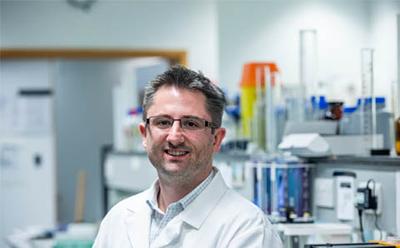Biochemists explore new reagents to unlock potential of proteins

Researchers at the University of Southampton will chemically modify proteins with novel reagents in a new project that could unravel molecular mechanisms underlying key cellular communication networks. Successful findings from the study could speed the discovery of new therapeutics targeting these networks.
Dr Matthias Baud, of the School of Chemistry, will use a New Investigator Award from the Engineering and Physical Sciences Research Council (EPSRC) to explore a new method to shed light on the function of a common but little understood component of cellular proteins.
The research will develop new biocompatible chemical reagents and methods for modifying the structure of proteins, both in vitro and in living cells, to try to unravel the function of post-translational modifications (PTMs) found in key cysteine residues.
Cysteine oxidation has attracted increasing interest in recent years due to cumulative evidence of its key role in several critical and complex cellular processes, however little is known about these omnipresent PTMs due to a lack of methods to study them in the laboratory.
“We recently discovered a way to mimic nature’s ability to tag proteins with these PTMs,” Matthias explains. “Using a combination of chemical and biological methods, we are now undertaking a new exciting programme of research to shed light on how these PTMs influence the structure, stability and behaviour of proteins. These new methods will be central for elucidating the complex cellular communication pathways controlled by these PTMs, and potentially to develop new treatments for diseases where they are dysregulated.”
It is estimated that up to 12 percent of all cysteines in the human proteome is in an oxidised form in cells and tissues. For example, cysteine sulfinic acid (Cys-SO2H, or CSA) is alone thought to account for around five percent of accessible cysteines in the human proteome.
Current methods for the preparation of CSA have proven extremely laborious and relied on treating a cysteine thiol (Cys-SH) containing peptide/protein of interest (POI) with oxidising agents such as hydrogen peroxide or peroxyacids. Such methods are particularly inefficient and produce complex mixtures of oxidised POIs, further hampering purification and accurate characterisation in biochemical and biophysical assays. Developing new methods allowing their precise study in the lab will be critical to elucidate their function in human biology.
Matthias is now assembling a specialist team to spend the next 18 months developing the new chemical methodologies at the core of his project.
“While the core idea behind this project has been there for some time, its potential and breadth really started to crystallise when I joined the School of Chemistry in late 2016,” he says. “This award marks the beginning of a very important new chapter in our group’s research and I am very grateful to the EPSRC for their support.
“Successful results on this research could have serious implications in drug discovery and the development of new types of therapeutics, notably in cancer in neurodegenerative diseases resulting from unbalanced cysteine oxidation events. We hope to generate interest from the industrial sector in due time, and explore potential translational opportunities which could benefit patients in the long term.”